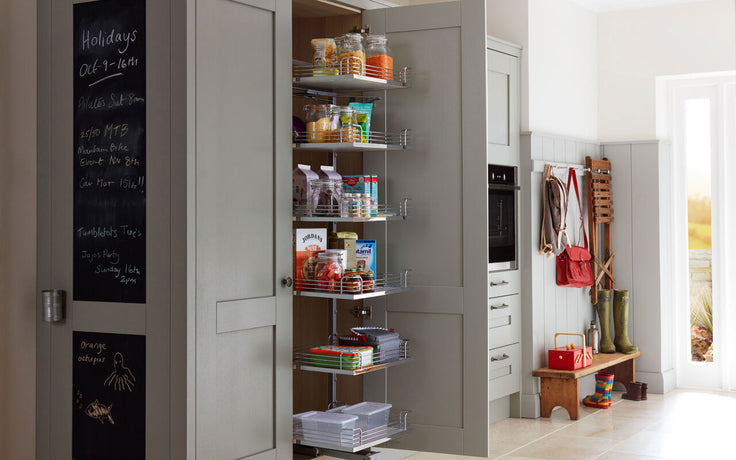- No products in the cart.
EXPLORING THE TIMELESS ELEGANCE OF LARDERS AND LARDER CUPBOARDS: A CULINARY JOURNEY
06
Aug
In the bustling modern world, where convenience and efficiency often take precedence, there's a charming and elegant tradition that has stood the test of time - the larder and its faithful companion, the larder cupboard. These unassuming yet indispensable elements of the culinary landscape have played an essential role in households for centuries, preserving food, enhancing flavors, and adding a touch of nostalgia to the heart of the home. In this article, we delve into the rich history, functionality, and enduring allure of larders and larder cupboards.
A Historical Perspective: Origins and Evolution of Larders
The concept of a larder can be traced back to medieval times, when households needed a dedicated space to store and preserve perishable items. The word "larder" itself has roots in the Old French term "lardier," which referred to a place where meat was stored. Originally, larders were simple, cool storage areas within homes or castles, often located near the kitchen for easy access to ingredients.
As society progressed and culinary practices evolved, so did the role of larders. In grand estates and manor houses, larders grew in size and complexity, accommodating not only meat but also a variety of other foodstuffs like dairy products, vegetables, and even wine. By the 18th and 19th centuries, larders had become integral components of well-equipped kitchens, embodying the principles of organization and efficiency that still resonate with us today.
Functionality and Design: Larders in the Modern Home
Fast-forward to the present day, and while modern refrigeration has transformed the way we store food, the charm of the larder remains evergreen. Larders continue to serve a vital purpose, albeit with a contemporary twist. Today's larders are often incorporated into kitchens as dedicated storage spaces, providing a separate area for the organized arrangement of ingredients, utensils, and other culinary necessities.
Enter the larder cupboard, a refined and elegant evolution of its predecessors. Larder cupboards combine the aesthetics of traditional larders with the convenience of modern cabinetry, offering an all-in-one solution for storage and organization. These cupboards are designed with multiple shelves, drawers, and compartments, allowing homeowners to neatly stow away pantry staples, cookware, and even small appliances, while maintaining a seamless and clutter-free kitchen.
The Allure of Larders and Larder Cupboards
What is it about larders and larder cupboards that captivates our imagination and endures through changing times? One aspect is undoubtedly their timeless aesthetic. Larder cupboards often feature intricate woodwork, decorative detailing, and elegant finishes, effortlessly blending classic design with contemporary functionality. Their presence adds a touch of sophistication to any kitchen, creating a focal point that pays homage to culinary traditions of the past.
Beyond their visual appeal, larders and larder cupboards provide a practical solution to the modern challenge of maintaining an organized and efficient kitchen. With ample storage space, these storage solutions enable homeowners to keep their ingredients and equipment neatly arranged, reducing clutter and making meal preparation a breeze. No more rummaging through overstuffed cabinets or navigating a maze of pantry items – larders bring order to the chaos.
Cultivating Culinary Excellence: The Larder as a Source of Inspiration
For the passionate home cook or professional chef, the larder serves as more than just a storage space – it's a treasure trove of inspiration. A well-stocked larder can be a source of creativity, encouraging experimentation with flavors and ingredients. Imagine opening the doors of a larder cupboard and discovering an array of spices, condiments, and specialty items that spark ideas for new and exciting dishes. The larder becomes a sanctuary for culinary exploration, where the possibilities are limited only by one's imagination.
Furthermore, larders can play a crucial role in preserving the authenticity of regional cuisines and culinary traditions. In an era when mass-produced and processed foods often dominate the market, having a larder stocked with locally sourced and artisanal ingredients allows cooks to honor the flavors and techniques that have been passed down through generations. Larder cupboards, with their customizable compartments, provide the ideal environment for storing and showcasing these culinary treasures.
Embracing Tradition in a Modern World: Incorporating Larders into Contemporary Living
As the world continues to embrace modern living, the resurgence of interest in larders and larder cupboards speaks to a desire for a balanced lifestyle that values both convenience and tradition. Many homeowners are now seeking ways to integrate the charm of larders into their contemporary spaces. Whether through bespoke cabinetry that mimics the appearance of a classic larder or by repurposing existing storage areas into functional larder spaces, the options are as diverse as the tastes and preferences of individuals.
These culinary companions have weathered the ages, adapting and evolving to meet the needs of each era while retaining their timeless appeal. From medieval storerooms to modern kitchen focal points, larders continue to captivate and inspire, reminding us of the joys of culinary exploration, organization, and the enduring beauty of tradition. So, whether you're a fervent foodie or a design enthusiast, consider embracing the elegance of larders and larder cupboards – for they are not just spaces to store ingredients, but gateways to a world of culinary wonder.
Creating a Larder Oasis: Design Tips and Practical Considerations
If you've been captivated by the allure of larders and larder cupboards, you might be eager to embark on a journey to incorporate these elegant storage solutions into your own home. To help you create a larder oasis that seamlessly combines functionality and aesthetics, here are some design tips and practical considerations to keep in mind:
1. Space Planning and Location: Before diving into the design process, carefully assess your available space and consider where the larder or larder cupboard would best fit. While a standalone larder cupboard can be a striking focal point, integrating a larder into your existing kitchen layout can offer a harmonious and seamless look. Aim for a location that is easily accessible from the main cooking and prep areas, ensuring that you can effortlessly retrieve ingredients while working your culinary magic.
2. Customization and Interior Layout: One of the key advantages of larder cupboards is their customizable interior layout. Take the time to plan the compartments, shelves, and drawers according to your specific needs. Consider incorporating features like pull-out baskets for produce, adjustable shelves for various-sized items, and specialized sections for spices, oils, and condiments. The goal is to create a well-organized space that caters to your cooking style and preferences.
3. Material Selection: When choosing the materials for your larder or larder cupboard, opt for high-quality, durable options that resonate with your design aesthetic. Wood is a popular choice, offering a classic and warm appearance. Consider finishes that complement your kitchen's overall theme, whether it's a rustic farmhouse style or a sleek, modern look.
4. Lighting and Ambiance: Don't underestimate the impact of lighting in enhancing the ambiance of your larder space. Incorporating soft LED lighting can not only illuminate the contents of your larder but also create a cozy and inviting atmosphere. Adjustable lighting can make a significant difference in both functionality and aesthetics, ensuring that every corner of your larder is well-lit and easily accessible.
5. Sustainable Practices: Embracing the tradition of larders can also align with sustainable living practices. Consider stocking your larder with locally sourced, organic ingredients and reducing packaging waste by purchasing items in bulk. By supporting local farmers and producers, you contribute to a more environmentally friendly approach to food consumption, all while honoring the historical roots of the larder.
6. Showcasing Culinary Treasures: Transform your larder or larder cupboard into a showcase of culinary treasures. Arrange ingredients in a visually appealing manner, placing artisanal jars, decorative containers, and labeled glass canisters on display. This not only adds to the aesthetic appeal of your larder but also makes it easier to locate and access ingredients when cooking.
7. Maintenance and Organization: As you embark on your culinary journey with your newly designed larder, remember that organization is key to its continued functionality. Regularly take stock of your supplies, rotate items to prevent spoilage, and clean the shelves and compartments to maintain a fresh and inviting space. The beauty of a well-organized larder lies in its ability to streamline your cooking process and simplify your meal preparation routine.
8. Embracing Modern Innovations: While larders evoke a sense of nostalgia, don't hesitate to embrace modern innovations that enhance their functionality. Incorporate features like pull-out trays, temperature-controlled sections, and built-in wine racks to cater to your specific needs. Balancing tradition with modern convenience allows you to create a larder space that is both practical and luxurious.
By incorporating these elegant storage solutions into your home, you not only honor the culinary practices of generations before you but also create a functional and inspiring space that enhances your culinary adventures. So, whether you're a dedicated home cook, an interior design enthusiast, or simply someone who appreciates the beauty of tradition, consider embarking on the journey of designing your very own larder oasis – a space where culinary delights and timeless elegance converge.
Larders as Culinary Museums: Preserving History and Flavor
Beyond their practical and aesthetic appeal, larders and larder cupboards serve as living testaments to the evolution of culinary history and flavor profiles. These spaces not only store ingredients but also house the stories of generations past, preserving traditional recipes, techniques, and ingredients that have shaped the way we eat and cook today. Let's delve deeper into how larders function as culinary museums, preserving the essence of time-honored flavors and techniques.
1. Guardians of Tradition: Larders are repositories of culinary wisdom, safeguarding recipes and techniques that have been passed down through generations. As culinary trends ebb and flow, these spaces remain steadfast, holding onto time-tested ingredients and methods that are the foundation of regional and cultural cuisines. From the sauerkraut of Germany to the kimchi of Korea, larders house the ingredients required to create dishes that have stood the test of time.
2. An Ode to Preservation: Preservation methods, once vital for survival, have become an integral part of gastronomic exploration. Larders continue to support the practice of pickling, fermenting, curing, and drying ingredients, allowing us to experience the rich flavors of preserved foods. The tangy snap of a homemade pickle or the complex umami notes of aged cheese tell stories of patient craftsmanship and a deep understanding of the alchemical processes that transform raw ingredients into culinary treasures.
3. Culinary Archaeology: Opening the doors of a well-stocked larder is akin to embarking on a culinary archaeological expedition. Every jar of preserved fruit, every tin of spices, and every bundle of dried herbs provides a glimpse into the flavors of the past. These ingredients often hark back to eras when access to fresh produce was limited, prompting resourceful preservation methods that not only extended shelf life but also intensified flavors.
4. A Lesson in Seasonality: Larders celebrate the rhythm of seasons, encouraging an appreciation for ingredients that ebb and flow with nature. In a world where out-of-season produce is often available year-round, larders remind us of the joy of anticipation – looking forward to the first harvest of spring peas, the burst of summer berries, or the comforting root vegetables of winter. By preserving seasonal abundance, larders allow us to experience the essence of each season's offerings even when they're not readily available.
5. Showcasing Cultural Identity: Cultural identity is deeply intertwined with culinary practices, and larders are a canvas upon which this identity is proudly displayed. The contents of a larder often reflect the culinary heritage of a region, with unique spices, condiments, and preserved ingredients that speak to the flavors that define a culture. Larders stand as beacons of cultural diversity, reminding us of the interconnectedness of food, tradition, and identity.
6. Inspiring Culinary Creativity: While larders preserve tradition, they also inspire creativity by offering a canvas for experimentation. The varied assortment of ingredients allows cooks to combine traditional elements with modern twists, crafting dishes that pay homage to the past while embracing contemporary flavors and techniques. The larder becomes a playground for innovation, where classic ingredients become the building blocks for culinary masterpieces.
Incorporating a larder or larder cupboard into your home is not just an exercise in design; it's a journey into the heart of culinary history. These spaces capture the essence of flavors that have spanned generations, inviting you to explore the world of preservation, seasonality, and cultural diversity. As you organize and stock your larder, remember that you are not only creating a functional space but also curating a culinary museum that honors tradition, preserves history, and celebrates the art of flavor.













